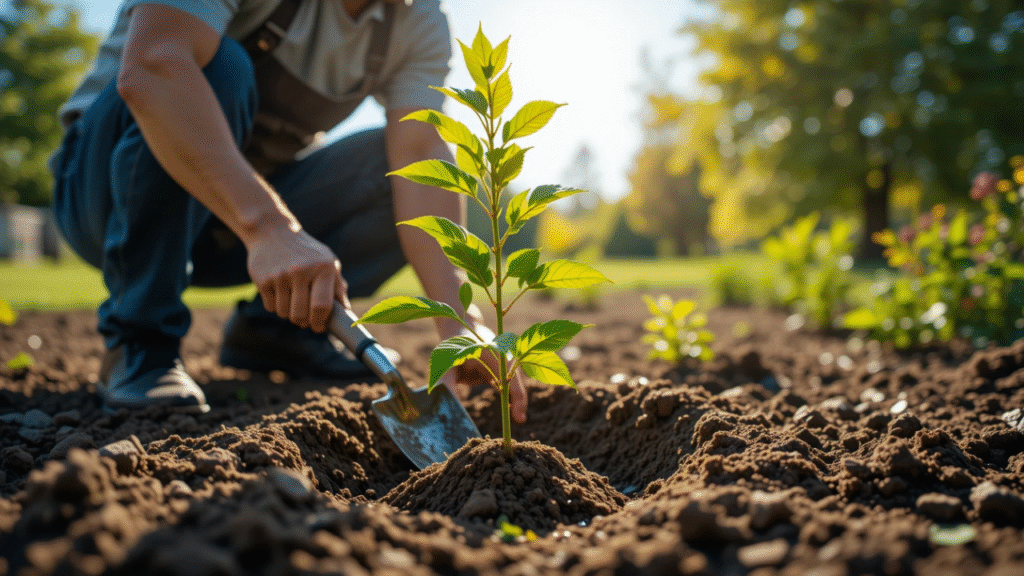
How to Grow and Care for an Ash Tree Sapling: Expert Tips for Healthy Growth and Strong Roots
If you’re dreaming of a beautiful, strong tree that will thrive for decades, planting an ash tree sapling could be your perfect starting point. These resilient trees are not only an asset to your landscape but also contribute to the environment by providing shade, purifying the air, and supporting local wildlife. But here’s the catch: growing a healthy ash tree sapling requires more than just planting it in the ground and hoping for the best.
Whether you’re a beginner gardener or just looking to refresh your tree care knowledge, this guide will walk you through everything you need to know. From choosing the right sapling and planting it correctly to ensuring it gets the right amount of water and care, we’ll break down each step for you.
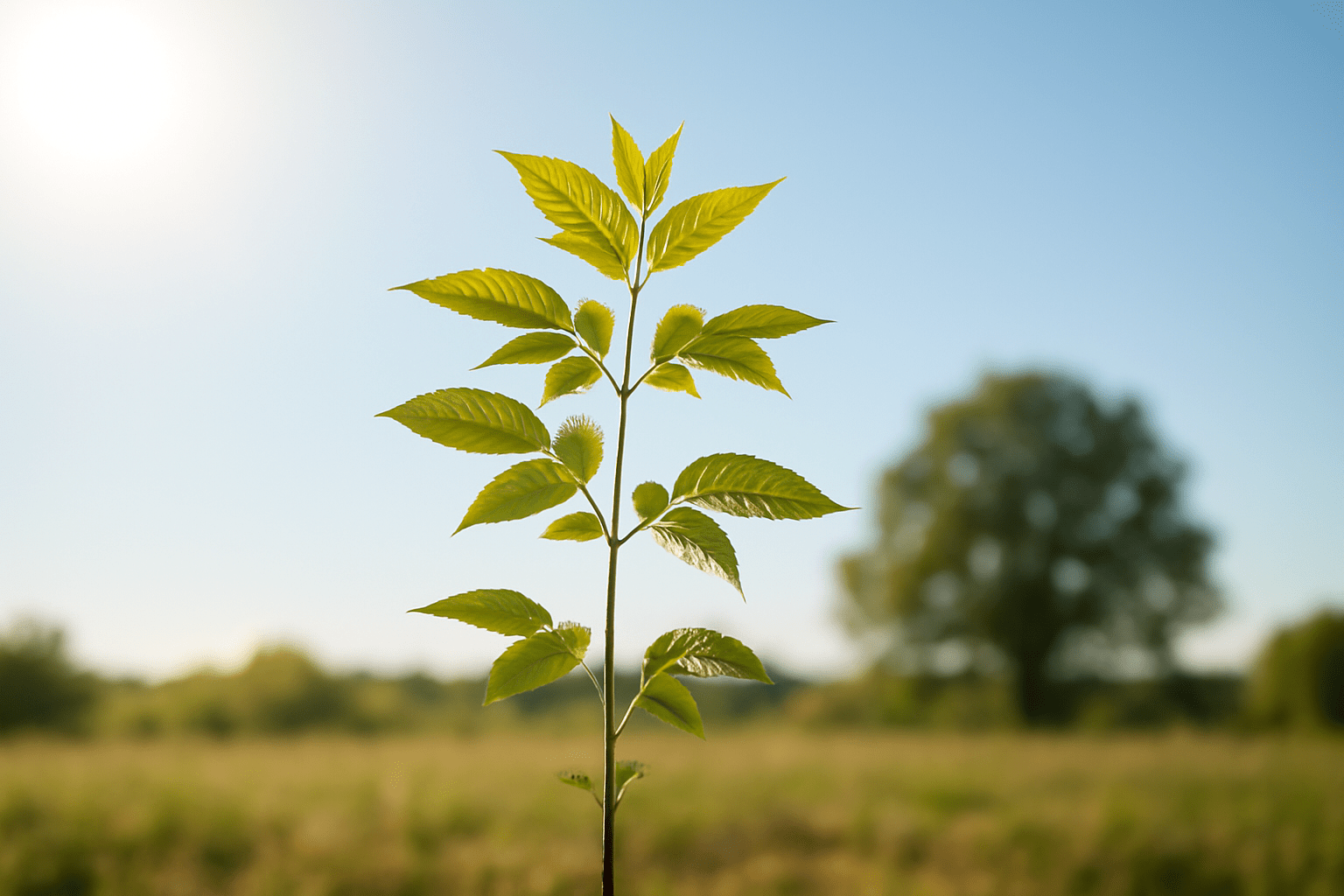
By the end, you’ll have the confidence and know-how to grow a thriving ash tree that can stand tall and strong for years to come. Ready to turn that sapling into a magnificent tree? Let’s dive in! 🌱
Table of Contents
Toggle🌳 Understanding Ash Tree Saplings: What You Need to Know 🌳
Before you start planting, it’s important to understand what an ash tree sapling is and why it’s such a great choice for your garden. An ash tree sapling is simply a young ash tree, typically under 5 feet tall, that is still in its early stages of growth. These saplings are your future big, beautiful trees, but they require special care to establish strong roots and grow into healthy, sturdy trees. 🌱
🌱 What Makes Ash Trees Special?
Ash trees are known for their rapid growth and resilience. They can thrive in a wide range of climates and soils, making them a popular choice for landscaping. Whether you’re looking to create shade, attract wildlife, or simply enhance your outdoor space, an ash tree sapling can be a perfect addition to your garden.
However, just because ash trees are hardy doesn’t mean they don’t need some TLC in the early stages. Giving your sapling the right start will ensure it thrives for years to come. 🌿
🌿 Common Types of Ash Trees
There are several types of ash trees, but the most common ones you might come across are:
- White Ash: Known for its beautiful green leaves that turn yellow in the fall and its strong wood, ideal for shade.
- Green Ash: A fast-growing variety that can withstand tough conditions, including droughts.
- Black Ash: Often used for its striking appearance and adaptability to wet conditions.

When choosing your sapling, make sure to pick a variety that suits your local climate and soil type. This will give your tree the best chance to thrive! 🌍
🌸 What You Can Expect in the First Few Years
In the first couple of years, your ash tree sapling will need some extra attention to establish its roots. During this period, it’s essential to make sure the sapling gets plenty of water, the right soil conditions, and protection from pests. This care will set the foundation for strong, healthy growth. 🌱
So, now that you understand the basics of ash tree saplings, you’re ready to dive into the next steps of planting and caring for your new tree! 🌳💪
Selecting the Right Ash Tree Sapling for Your Garden 🌱
Choosing the right ash tree sapling is a crucial step in ensuring your tree grows strong and healthy. Not all ash trees are the same, so it’s important to select one that suits your garden’s conditions. Let’s break down the key factors to consider when making your choice! 😊
🌿 1. Check for Healthy Saplings
First things first, look for a sapling that is in good health. Here’s how to spot a strong, healthy ash tree sapling:
- Strong Stem: The trunk should be straight and firm, without any signs of rot or damage.
- Green Leaves: The leaves should be vibrant and free from discoloration or spots, which could indicate pests or diseases.
- Well-Formed Roots: Gently lift the sapling from its container to check the roots. They should be white, not brown or mushy, and not circling too tightly around the pot.
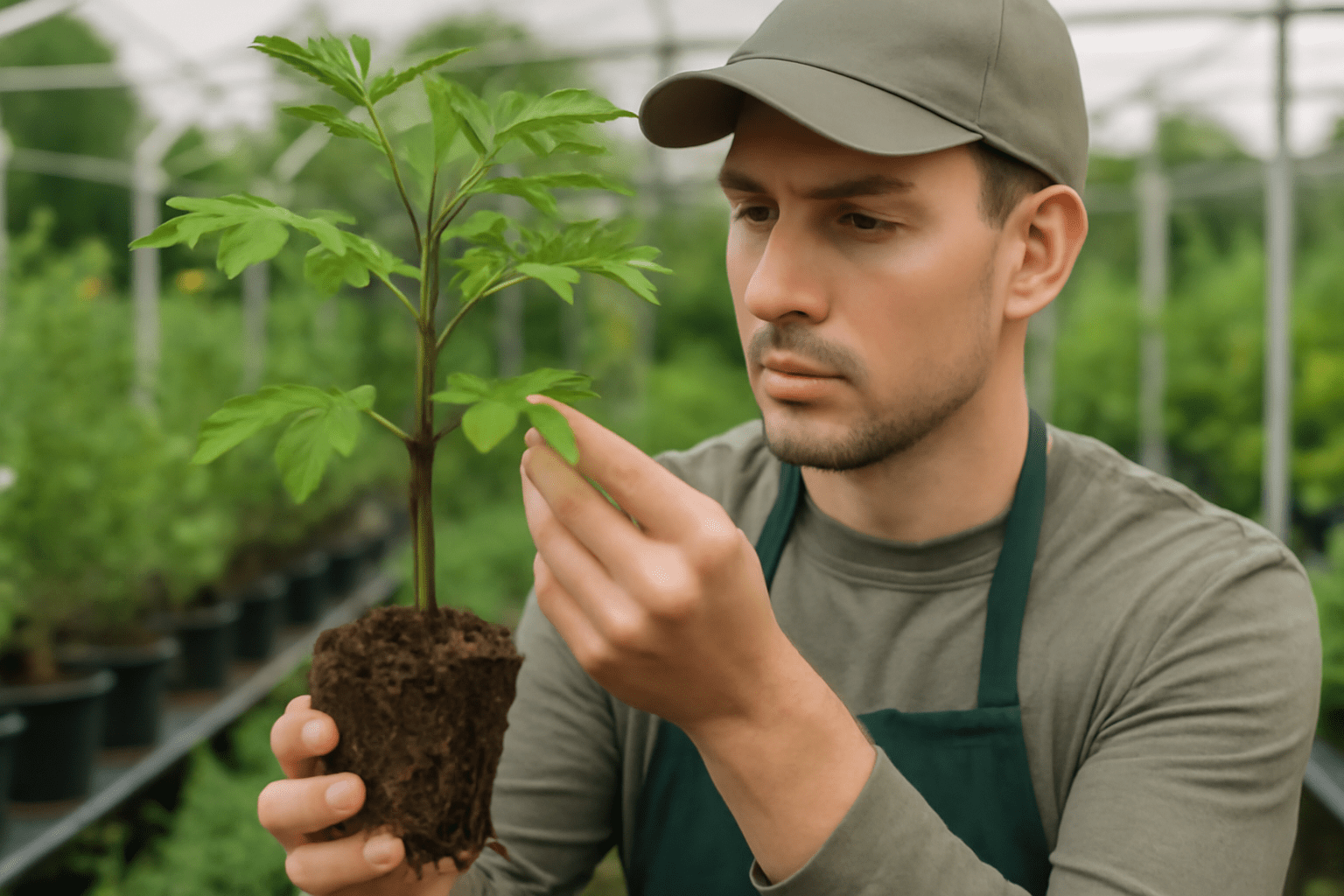
A healthy sapling is your first step towards success! 🌱
🌍 2. Choose the Right Variety for Your Climate
Different varieties of ash trees thrive in different climates and soil types. Here are a few varieties you might consider, depending on where you live:
- White Ash: Ideal for temperate climates with well-drained soil. It grows tall and offers great shade.
- Green Ash: Perfect for areas with fluctuating weather conditions or drought-prone regions. This variety can handle tougher soil and harsher climates.
- Black Ash: Prefers wet soils and is often found near ponds or marshes. It’s ideal for areas with more moisture.
Make sure to choose a variety that will thrive in your area’s specific conditions! 🌞
🌳 3. Consider the Space in Your Garden
Ash trees are large, so think about the space available in your garden before making your choice.
- Space for Growth: Ash trees can grow up to 80 feet tall and 40 feet wide, so choose a spot with plenty of room for the sapling to grow both vertically and horizontally.
- Avoid Overcrowding: Plant your sapling away from structures like fences, buildings, or other trees to allow for natural expansion.
A little planning now can prevent overcrowding down the line! 🏡
🌸 4. Buy from a Trusted Nursery or Garden Center
While it’s tempting to buy a sapling online, visiting a local nursery or garden center ensures you’re getting a healthy, regionally appropriate tree. A reputable seller will often provide guidance on the best varieties for your area and will have quality saplings that have been well-cared for. 🌻
🌍 5. Look for Disease Resistance
While ash trees are generally hardy, some varieties are more resistant to pests and diseases than others. For example, Green Ash is typically more resistant to the invasive emerald ash borer, a pest that threatens ash trees in many parts of North America. If you’re concerned about local pests, it’s worth researching which variety has the best chance of survival in your area. 🔍
By considering these factors, you’ll be on your way to selecting the perfect ash tree sapling for your garden. With a little thought and care, your tree will grow to be a beautiful addition to your landscape! 🌳
Planting Your Ash Tree Sapling: A Step-by-Step Guide 🌿
Planting an ash tree sapling is an exciting yet important process that requires a little bit of patience and attention to detail. To ensure your sapling gets the best start, follow this step-by-step guide to planting it the right way. 🌱
🌍 1. Choose the Right Time to Plant
The best time to plant your ash tree sapling is during early spring or fall. This is when the soil is warm enough to support root growth but not too hot to stress the sapling.
- Spring: The ideal time for planting is when the danger of frost has passed but the soil is still moist.
- Fall: This is a great time too, as the cooler temperatures allow the roots to establish before the winter.
🌞 2. Select the Perfect Spot
Choose a location that provides the conditions your ash tree sapling needs to thrive:
- Sunlight: Ash trees love full sunlight. Pick a spot that gets at least 6 hours of direct sun each day.
- Space: Remember, ash trees can grow tall and wide, so ensure there’s enough room for them to expand. Avoid planting near structures, other trees, or power lines. 🌳
- Well-Drained Soil: Ash trees prefer well-draining soil. Avoid areas with standing water after rainfall, as this can lead to root rot. If your soil tends to be heavy or clayey, consider improving it with compost or sand to aid drainage.
🕳️ 3. Dig the Hole
Now that you’ve picked the right spot, it’s time to dig the hole. Here’s how:
- Size of the Hole: The hole should be twice as wide as the root ball and the same depth. This gives the roots plenty of room to spread and grow.
- Loosen the Soil: Use a shovel or garden fork to loosen the soil at the bottom and sides of the hole. This will make it easier for the roots to grow into the surrounding soil. 🌱
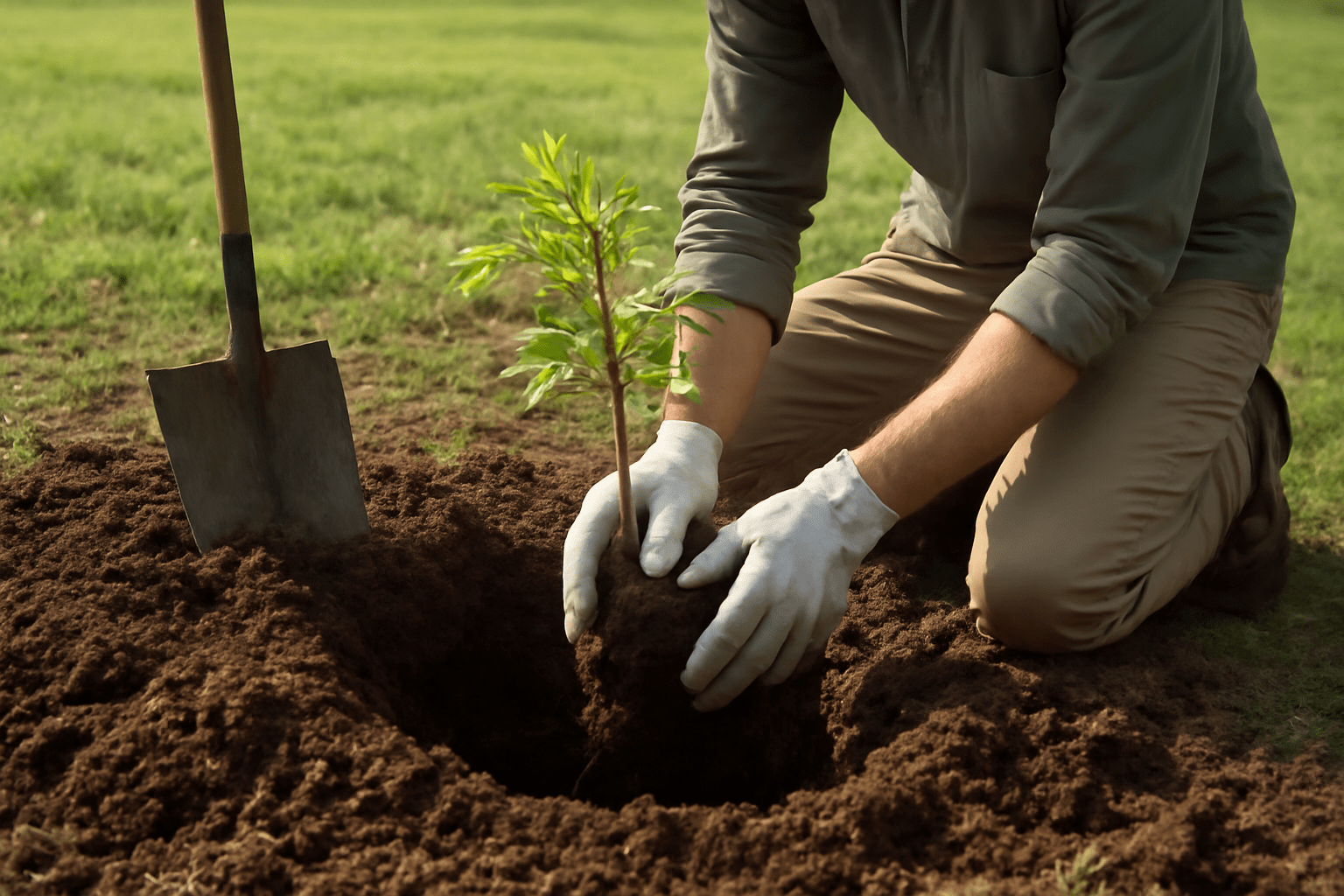
🌿 4. Prepare the Sapling
Before planting, it’s important to prepare your ash tree sapling for its new home:
- Remove the Sapling from the Pot: Gently remove the sapling from its container. If the roots are tightly packed or circling the root ball, carefully loosen them with your fingers. This prevents the roots from becoming bound as the tree grows.
- Examine the Roots: Check for any broken or diseased roots and trim them off with clean, sharp scissors or pruning shears. Healthy roots should be white and firm, not brown or mushy. 🌱
🌱 5. Position the Sapling in the Hole
Now, it’s time to place the sapling in the hole:
- Placement: Position the sapling in the center of the hole, ensuring that the top of the root ball is level with or slightly above the surrounding soil. You don’t want to bury the trunk or roots too deep, as this can lead to poor growth.
- Straighten the Trunk: Make sure the sapling is standing straight, as this will help it grow upward and avoid leaning later on.
🌍 6. Backfill and Water
Once the sapling is in place, it’s time to backfill the hole:
- Fill the Hole: Gently fill the hole with the soil you removed, making sure to pack it lightly as you go. This prevents air pockets from forming around the roots.
- Water Generously: After backfilling, water the sapling thoroughly. This helps settle the soil around the roots and ensures they’re properly hydrated. Aim to keep the soil moist, but not soggy, for the first few months while the roots are establishing.
🌿 7. Mulch Around the Base
Mulching is essential to keep the soil moist and protect the roots from extreme temperatures:
- Apply Mulch: Spread a 2-3 inch layer of mulch around the base of the sapling, keeping it away from the trunk to prevent rot. Mulch helps retain moisture, suppress weeds, and regulate soil temperature.
- Keep It Tidy: Make sure the mulch doesn’t touch the sapling’s trunk, as this can cause the bark to rot over time. 😊
🪴 8. Stake the Sapling (Optional)
If you live in a windy area or if your sapling is tall and thin, it might need some extra support during the early stages. Here’s how to stake your sapling properly:
- Use a Soft Tie: Avoid using wire or anything that could damage the trunk. Use a soft material like cloth or a commercial tree tie.
- Stake Placement: Place the stake about 18 inches from the sapling’s trunk and tie the sapling loosely to the stake. The goal is to keep the tree from swaying too much, but still allow some movement to encourage strong root development.
🌞 9. Watering and Care After Planting
Once planted, your ash tree sapling will need consistent care:
- Watering: Keep the soil consistently moist for the first few months. Water deeply to encourage root growth, especially during dry spells. 🌧️
- Check for Pests: Regularly inspect your sapling for pests or signs of disease, especially in the first few years.
By following these steps, your ash tree sapling will have the best chance to grow into a healthy, strong tree. With time, patience, and proper care, you’ll watch it transform into a beautiful, towering addition to your garden! 🌳💚
💧 Watering and Fertilizing Your Ash Tree Sapling 💧
Proper watering and fertilizing are essential to help your ash tree sapling thrive 🌱. These two key factors will ensure that your sapling grows strong, healthy roots and branches 🌳. Let’s break down how to water and fertilize your sapling to give it the best possible start. 🌿
💦 1. Watering Needs for Your Ash Tree Sapling 💦
Watering is crucial, especially during the early years when your ash tree sapling is establishing its roots. Here’s how to make sure your tree gets just the right amount of water 🌧️:
Frequency of Watering:
- First Year: During the first year 🌱, your sapling will need frequent watering—about 2-3 times a week. If the weather is particularly hot 🔥 or dry, you may need to water more often.
- After the First Year: As your sapling grows 🌳, you can reduce watering to once a week, but make sure to increase the amount of water 💦 each time. Deep watering encourages strong root growth 🌿.
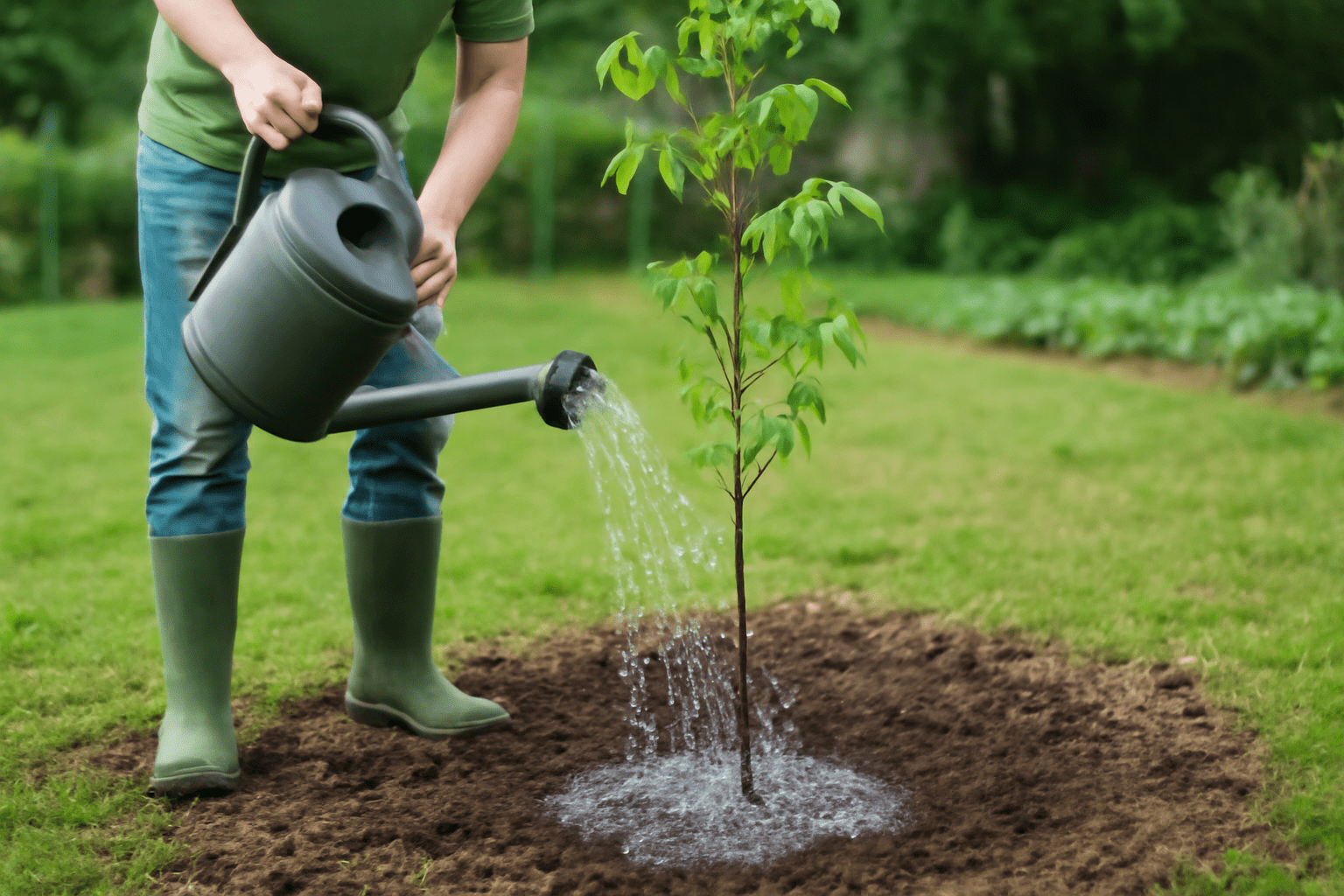
How to Water:
- Deep Watering: Water the sapling deeply 💧 so the moisture reaches the root zone. A slow trickle from a hose or a deep-watering nozzle is ideal 🌊. Avoid shallow watering, which only wets the top layer of soil 🏜️.
- Avoid Overwatering: While ash trees need consistent moisture 🌦️, they do not like soggy roots 🚫. Ensure the soil drains well and avoid waterlogging, which can lead to root rot 💀.
Signs of Underwatering:
If you notice yellowing 🌼 or wilting leaves 🍂, this could be a sign of insufficient watering. Your tree will need more moisture during dry spells 🌞.
🌿 2. Fertilizing Your Ash Tree Sapling 🌿
Fertilizing is important to promote healthy growth 🌱, but it must be done correctly to avoid damaging the tree 🌳. Here’s how to fertilize your ash tree sapling for the best results 🌾:
Type of Fertilizer:
- Slow-Release Fertilizer: Choose a slow-release granular fertilizer designed for trees 🌳. These types of fertilizers release nutrients gradually 🌱, providing your sapling with a steady supply of food throughout the growing season 🌞.
- Organic Fertilizers: Organic options like compost 🧑🌾 or well-rotted manure 🐄 are also great choices. These improve soil health 🌿 and provide balanced nutrients over time ⏳.
When to Fertilize:
- Spring and Early Summer: The best time to fertilize your ash tree sapling 🌳 is in early spring 🌸, just as the tree begins its growing season. This will give it a boost of energy to start strong 💪.
- Avoid Late Fertilizing: Don’t fertilize in late summer 🌞 or fall 🍂. Fertilizing too late can encourage new growth that is too tender 🌱 to survive the colder months ❄️.
How Much to Fertilize:
Apply fertilizer according to the package instructions 📦, based on the size of your sapling and the type of fertilizer you are using 🌾. Over-fertilizing can be harmful 😨, causing rapid, weak growth that makes your tree more susceptible to pests 🐜 and disease 🦠.
Spread the fertilizer evenly around the tree’s base 🏡, but keep it a few inches away from the trunk to prevent root burn 🔥.
🌱 3. Mulching for Moisture Retention 🌱
In addition to watering 💦 and fertilizing 🌿, mulching is an excellent way to help your ash tree sapling retain moisture 🌧️ and keep its roots cool 🌡️ during hot months. Here’s how to mulch properly 🌸:
Type of Mulch:
Use organic mulches like wood chips 🌳, bark 🌿, or leaf litter 🍂. These break down over time and add nutrients to the soil 🌍.
How to Apply:
Spread a 2-3 inch layer of mulch around the base 🌳 of the tree, but keep it a few inches away from the trunk 🚫 to prevent rot. Mulch helps retain moisture 💧, prevent weed growth 🦠, and regulate the soil temperature 🌡️.
By following these simple watering 💦 and fertilizing 🌾 guidelines, you’ll provide your ash tree sapling with everything it needs to grow strong 💪 and healthy 🌱. With consistent care, your sapling will develop deep roots 🌳 and strong branches that will last for generations to come 🕰️. 🌳💧
✂️ Pruning and Maintenance: Keeping Your Ash Tree Sapling Healthy ✂️
Pruning and regular maintenance are key to ensuring that your ash tree sapling grows strong and healthy 🌱. Proper care in the early years sets the foundation for a tree that thrives for decades to come 🌳. Here’s how to prune and maintain your sapling to encourage strong growth and a beautiful shape 🌟.
🌿 1. When and How to Prune Your Ash Tree Sapling 🌿
Pruning helps your sapling develop a strong, well-structured canopy and ensures that dead or damaged branches don’t hold the tree back. Follow these steps to prune correctly ✂️:
Best Time to Prune:
The best time to prune your ash tree sapling is late winter or early spring, before new growth begins 🌸. Pruning during dormancy reduces the risk of disease and allows the tree to heal quickly 💪.
What to Prune:
- Dead or Damaged Branches: Remove any branches that are dead, broken, or diseased 🌿. This will help prevent the spread of disease and encourage healthy growth 🌳.
- Crossing or Rubbing Branches: If you notice branches rubbing against each other, prune the weaker one to avoid bark damage 🐛.
- Shaping the Tree: As your sapling grows 🌱, gently shape the tree by cutting back any branches that grow too low or don’t align with the tree’s natural form 🍃. Aim for a central leader (main stem) and a strong branching structure 🌳.
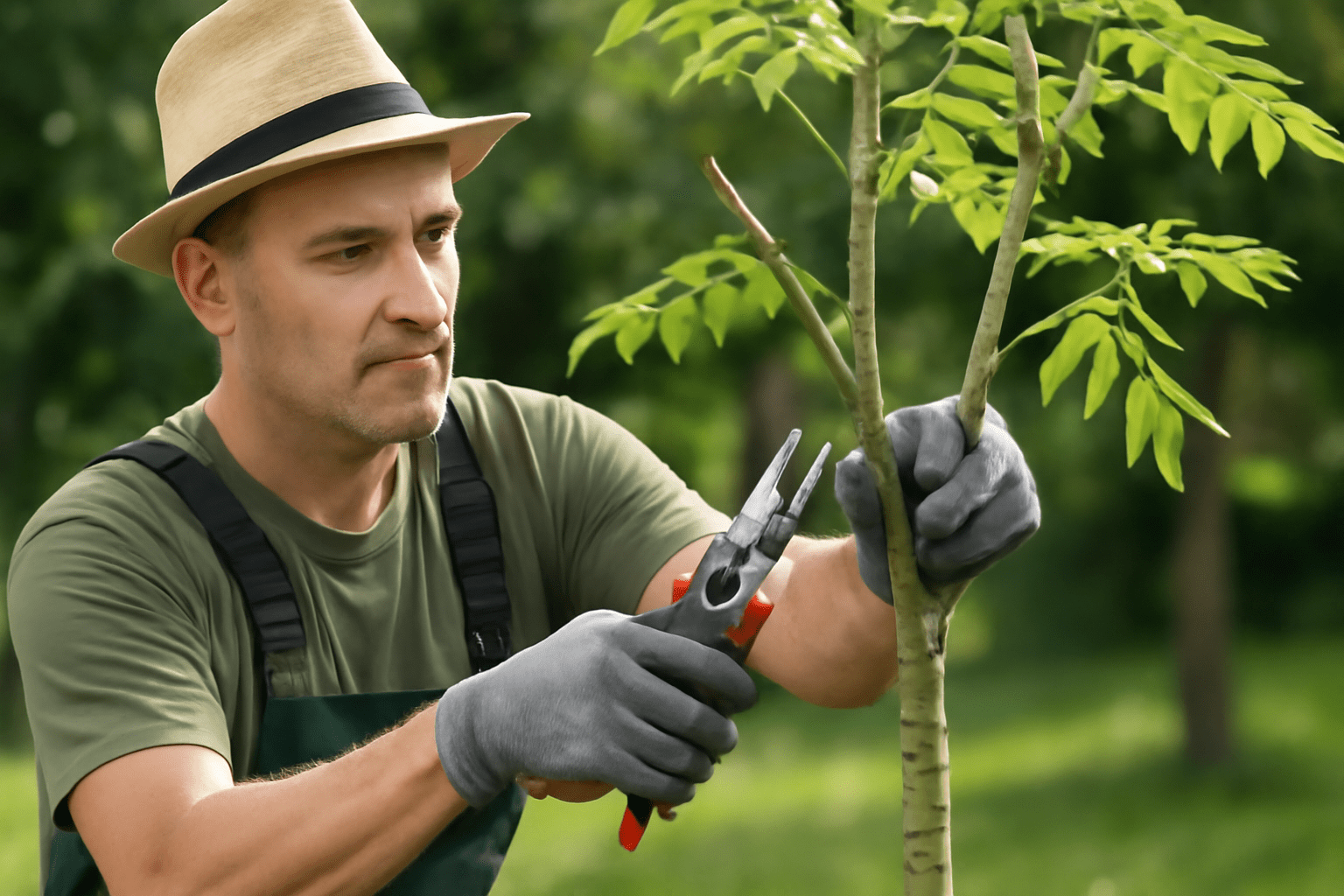
Pruning Tools:
Use clean, sharp pruning shears ✂️ or loppers to make smooth cuts. Avoid tearing the bark or leaving jagged edges, as these can create entry points for pests 🐜 and diseases 🦠.
🌱 2. Mulching and Soil Maintenance 🌱
In addition to pruning, regular soil and mulch maintenance is vital for your sapling’s long-term health 🌳.
Mulching Benefits:
Applying mulch around the base of your sapling helps retain moisture 💧, keeps the soil temperature stable 🌡️, and prevents weeds from competing for nutrients 🌾. Use organic mulches like wood chips, bark, or leaves 🍂, and apply a 2-3 inch layer.
Mulch Placement:
Be sure to leave a small gap between the mulch and the trunk to avoid moisture buildup, which could lead to rot 💀. Keep the mulch spread evenly around the tree’s base, extending out to the drip line (the outermost point of the tree’s branches) 🌳.
Soil Health:
Keep an eye on the soil around your sapling 🌍. Ash trees prefer slightly acidic to neutral soil (pH 6-7) 🌱. If you notice any signs of nutrient deficiencies, like yellowing leaves 🍂, consider testing your soil and amending it with compost or other organic matter 🌿.
🌳 3. Staking Your Sapling (If Needed) 🌳
If your ash tree sapling is young and tall, it might need some extra support during its early years 🌱. Staking helps prevent the tree from leaning and provides stability against winds or storms 🌪️.
When to Stake:
Only stake your sapling if it’s leaning or if it’s located in a particularly windy area 🌬️. If the tree is upright and stable, it doesn’t need staking ✋.
How to Stake:
- Use a soft material, such as cloth ties or a tree strap, to secure the sapling to the stake 🪢. Avoid using wire or anything that could cut into the trunk 🚫.
- Place the stake about 18-24 inches from the trunk, ensuring the tree can sway slightly 🌲. This slight movement helps strengthen the trunk over time 🏋️♂️.
- Leave the stake in place for no longer than one growing season 🌳. If left for too long, staking can inhibit the tree’s natural movement and growth 🚶♀️.
🌱 4. Monitoring for Pests and Diseases 🌱
Your ash tree sapling can fall victim to a variety of pests 🐛 and diseases 🦠, so it’s important to keep an eye on it and act quickly if you notice any problems 👀.
Ash Borer:
One of the most common pests that affect ash trees is the emerald ash borer, an invasive insect that targets the bark of ash trees 🐜. Watch for signs of damaged or curling leaves 🍂, holes in the bark, or sawdust-like material at the base of the tree 🪲.
Prevention:
If you’re in an area where emerald ash borer is common, consider planting pest-resistant ash varieties 🌳 or regularly treating the tree with insecticidal sprays 🐜.
Other Common Pests:
- Aphids: Small insects that feed on tree sap 🌿. They can be controlled using organic insecticidal soap 🧴 or by introducing beneficial insects like ladybugs 🐞.
- Scale Insects: These pests can create a sticky residue on leaves 🍂 and branches. Remove them manually or treat with horticultural oil to suffocate the insects 🛢️.
Diseases to Watch For:
- Ash Dieback: This fungal disease causes leaves to wilt and die prematurely 🍂. Prune infected areas and remove any fallen leaves 🍁 to reduce the spread of the disease.
- Root Rot: Caused by overwatering or poor drainage 🌧️, root rot can be deadly ⚰️. Make sure your tree has well-draining soil 🏞️, and water it properly to avoid this condition.
🌞 5. Protecting Against Environmental Stress 🌞
Your sapling will be more vulnerable to environmental stress 🌡️ in its early years, so it’s important to help it adapt 🌱.
Watering in Dry Conditions:
During hot, dry spells 🌞, make sure to water your sapling deeply 💧 to keep the roots moist. Avoid shallow watering, which doesn’t reach deep enough 🏜️.
Avoid Over-Fertilizing:
While fertilizing is important 🌾, too much fertilizer can cause a surge in weak, unhealthy growth that’s more susceptible to pests and diseases 🐜. Stick to a balanced fertilization schedule 🗓️.
🌳 6. Ensuring Long-Term Growth 🌳
As your ash tree sapling grows 🌱, continue to monitor its health and shape 🌳:
Continue Pruning:
As your sapling matures 🌿, prune it annually to maintain its structure and remove any weak or crossing branches 🌳. This will help it grow straight and strong 💪.
Check for Root Development:
In a few years, check the root system to ensure it’s not becoming root-bound or restricted 🪴. If the tree’s roots are circling, you may need to gently loosen them to promote outward growth 🌍.
With proper pruning ✂️, maintenance 🌱, and pest management 🐛, your ash tree sapling will grow into a strong, beautiful tree 🌳. Keep an eye on its progress 👀 and provide the care it needs to flourish 🌸!
🛡️ Protecting Your Ash Tree Sapling from Pests and Diseases 🛡️
An ash tree sapling is susceptible to a variety of pests and diseases, especially in its early years 🌱. Protecting your sapling from these threats is crucial to ensure its long-term health and growth 🌳. With the right care and attention, you can safeguard your tree from damage and promote its overall well-being 🌿. Here’s how you can protect your sapling from common pests and diseases 🐞.
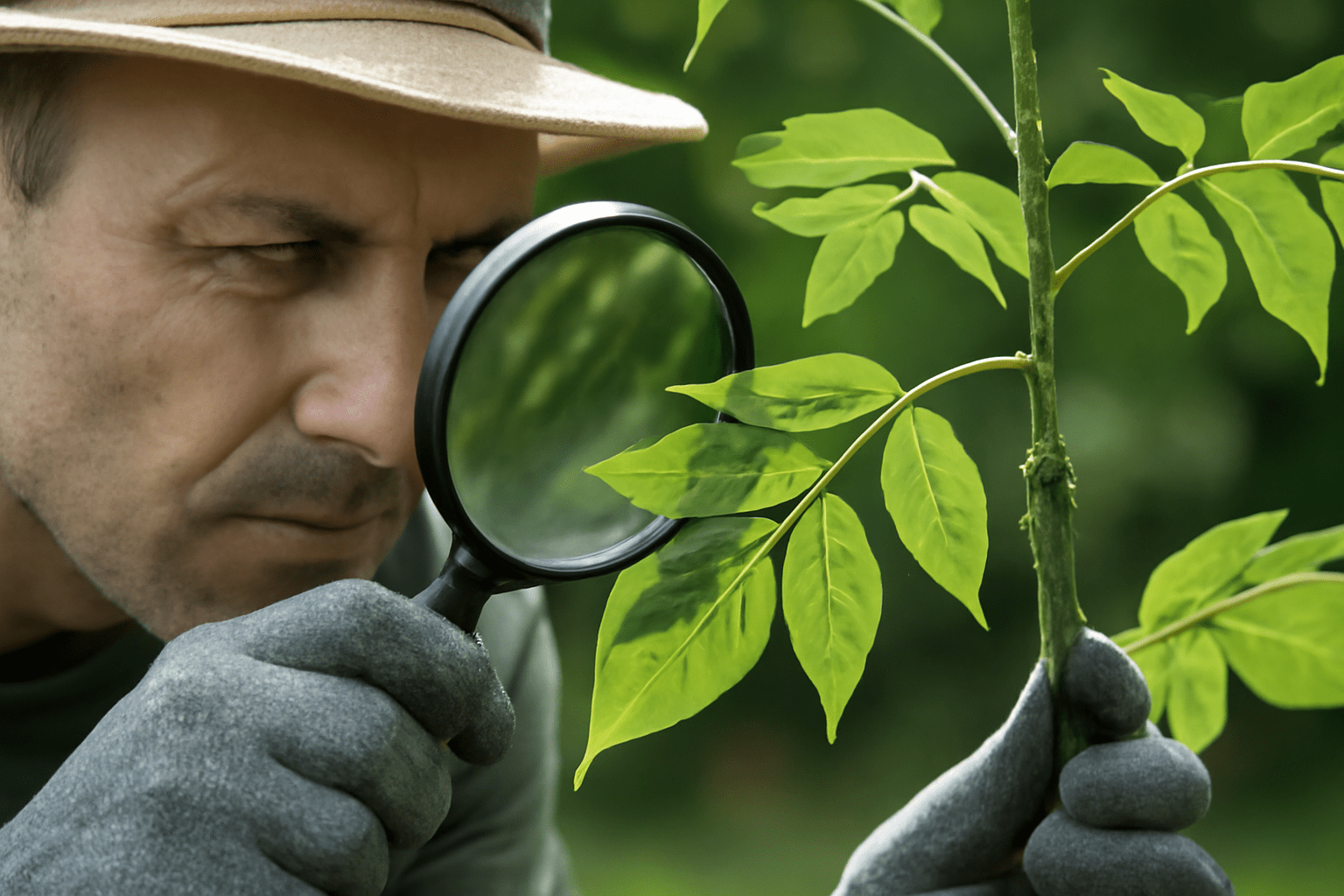
🐞 1. Common Pests Affecting Ash Trees 🐞
While ash trees are generally hardy, there are a few pests that pose a threat to them 👀. Here’s a look at some of the most common ones 🦠:
Emerald Ash Borer (EAB):
The most dangerous pest for ash trees 🌳, the emerald ash borer is an invasive beetle 🪲 that targets the tree’s bark. It creates small holes in the bark, disrupting the flow of nutrients and eventually killing the tree ⚰️.
Signs of EAB Infestation:
- Small, D-shaped holes in the bark 🔴
- Yellowing or wilting leaves 🍂
- Vertical splits in the bark 🌿
- A decrease in leaf growth 🌱
Prevention:
- If you’re in an area where EAB is common, consider planting EAB-resistant ash varieties 🌳.
- Use insecticidal treatments or tree injections specifically designed to target the emerald ash borer 💉. Apply them in spring or early summer 🌞.
- Regularly inspect your tree for signs of infestation 🔍, especially during its early years 🌱.
Aphids:
These tiny, sap-sucking insects 🐜 can damage your ash sapling by weakening the tree and causing distorted leaves 🍃. They also excrete a sticky substance known as “honeydew,” which attracts mold 🍄.
Signs of Aphid Infestation:
- Yellowing, curling, or deformed leaves 🍂
- Sticky residue on the leaves or ground 🍯
- Presence of ants (they’re attracted to honeydew) 🐜
Prevention and Control:
- Hose off aphids with a strong stream of water 💦 to physically remove them.
- Introduce natural predators, such as ladybugs 🐞, which feed on aphids.
- Use organic insecticidal soap 🧴 or neem oil 🌿 to safely control aphid populations.
Scale Insects:
These pests appear as small, oval-shaped bumps on the bark and leaves 🐛. They suck sap from the tree, weakening it over time ⏳.
Signs of Scale Infestation:
- Visible bumps or hard patches on the bark or leaves 🌿
- Yellowing or drooping leaves 🍂
- A sticky substance (honeydew) on the tree or surrounding surfaces 🍯
Prevention and Control:
- Use horticultural oil 🛢️ to suffocate the scales. Apply it in early spring when the pests are active 🌸.
- Prune affected branches ✂️ and remove any heavily infested leaves 🍁.
🦠 2. Common Diseases Affecting Ash Trees 🦠
In addition to pests, your ash tree sapling can also fall prey to several diseases 🦠. Monitoring for early signs of disease and taking prompt action is key to preventing further damage 🚨.
Ash Dieback:
This fungal disease causes leaves to wilt and die prematurely 🍂. It’s often spread by wind and rain 🌧️.
Signs of Ash Dieback:
- Wilting, brown, or blackened leaves 🍂
- Branches that die off prematurely 🌿
- Dark streaks or lesions on the bark 🌚
Prevention and Control:
- Prune dead or infected branches ✂️ to prevent the spread of the disease 🌿.
- Avoid working with your sapling during wet weather 🌧️, as this can spread the fungus.
- Remove fallen leaves 🍁 and debris from around the tree to reduce the spread of fungal spores 🌱.
- Consider applying a fungicide if you live in an area where ash dieback is common 🧴.
Root Rot:
Root rot is often caused by overwatering 🌧️ or poorly drained soil 🏞️. It leads to the decay of the tree’s roots, making it harder for the tree to absorb water and nutrients 💧.
Signs of Root Rot:
- Yellowing leaves 🍂
- Wilting, despite adequate watering 💦
- A sour or musty smell around the base of the tree 🌱
Prevention and Control:
- Ensure your tree is planted in well-draining soil 🌿. If your soil retains too much water 💧, consider adding sand or organic matter to improve drainage 🏞️.
- Water your sapling deeply but infrequently 💦, allowing the soil to dry out between waterings 🌞.
- If you suspect root rot, carefully remove the sapling from the soil 🪴 and inspect the roots. Trim away any soft, rotting roots and replant the sapling in fresh, well-draining soil 🌱.
Powdery Mildew:
Powdery mildew is a fungal disease that causes a white, powdery coating on the leaves 🌿, affecting photosynthesis and growth 🌞.
Signs of Powdery Mildew:
- White, powdery spots on the leaves ❄️
- Leaves that curl or become distorted 🍃
- Yellowing of the leaves 🍂
Prevention and Control:
- Prune the sapling to allow better airflow around the leaves 🌬️, reducing the humidity where mildew thrives 🦠.
- Remove affected leaves 🍂 and dispose of them away from your tree 🌳.
- Apply fungicides if necessary 🧴, or use natural remedies like a baking soda solution to treat the infection 🍞.
🌳 3. General Prevention Tips 🌳
In addition to dealing with specific pests and diseases 🐜, there are some general tips that can help you protect your ash tree sapling from a variety of threats 🦠:
Regular Inspections:
Check your tree weekly for signs of pests 🐛, diseases 🦠, or damage 🚨. Early detection is key to stopping problems before they get out of hand 👀.
Proper Spacing:
Ensure that your sapling has enough space to grow without being crowded by other plants 🌿 or trees 🌳. This reduces stress and improves airflow 🌬️, which helps prevent many diseases 🌱.
Clean Gardening Tools:
Always sanitize your pruning tools ✂️ before and after use to avoid transferring pests 🐛 or diseases 🦠 from one tree to another 🌍.
Proper Watering and Soil Care:
Healthy trees are less likely to fall victim to pests 🦠 and diseases 🦠. By maintaining healthy soil 🏞️, watering properly 💧, and providing adequate nutrients 🌾, you’ll give your sapling the best defense against external threats 💪.
By staying proactive and vigilant 👀, you can protect your ash tree sapling from common pests 🐛 and diseases 🦠 and ensure it grows strong and healthy 🌳. With a little effort 💪, your tree will thrive and flourish for many years to come 🌱! 🌳💚
🌿 Ensuring Long-Term Success: Growing into a Mature Ash Tree 🌳
Successfully growing an ash tree sapling into a mature, thriving tree takes time, patience, and proper care 🌱. While the early years are crucial for establishing strong roots and healthy growth, long-term success depends on the right ongoing maintenance and monitoring. Here’s how you can ensure your sapling grows into a strong, mature ash tree that will stand tall for decades 🌳.
🌿 1. Signs of Healthy Growth in Your Ash Tree Sapling 🌱
Before you move forward, it’s important to understand what healthy growth looks like 👀. Here’s what to look for as your ash tree sapling matures:
- Strong, Straight Trunk: Your sapling should grow with a strong, upright trunk. If the tree is leaning, you may need to stake it for support 🪴.
- New Growth: Look for fresh, vibrant leaves each spring 🌸. A healthy tree will consistently produce new shoots and branches 🌿.
- Healthy Leaves: The leaves should be a deep green, free from discoloration 🍂, spots, or wilting 🌞. Any signs of pests or disease should be addressed immediately 🛡️.
- Strong Root System: As your sapling grows, the root system will expand 🌍. Ensure the soil around the base of the tree remains firm and that the tree stays stable in the ground 🌳.
🌱 2. Transitioning to Less Frequent Watering 💧
Once your sapling’s root system has had time to establish, it’s time to start reducing the frequency of watering 🚰. Here’s how to transition:
- After 1-2 Years: Once your sapling is a couple of years old, reduce watering from 2-3 times a week to once a week. Water deeply each time to encourage the roots to grow deeper 🌱.
- Watering in Drought Conditions: Even if you reduce the frequency, water more often during dry spells 🌞. Deep watering helps establish strong, drought-tolerant roots 🌱.
- Signs You’re Overwatering: If the leaves start turning yellow 🍂 and the soil remains soggy, it might be a sign of overwatering 🚿. Adjust your watering schedule to let the soil dry out slightly between waterings.
🌿 3. Pruning for Strong Growth ✂️
Pruning isn’t just for shaping your tree—it also plays a vital role in ensuring healthy growth throughout the years 🌳. Proper pruning helps the tree develop a strong structure and removes any weak or diseased branches 🌿.
- Annual Pruning: Continue to prune your tree annually to remove dead or damaged branches 🌿 and maintain its shape. Focus on removing any crossing branches that could rub against each other and cause damage 🌳.
- Encouraging Strong Structure: If your tree is young, ensure the central leader (the main stem) is dominant 💪. Remove any competing branches that could weaken the tree’s structure 🌱.
- Pruning at the Right Time: Always prune in the late winter or early spring, before new growth begins 🌞. This minimizes the risk of introducing disease and helps the tree heal quickly 🍃.
🌳 4. Long-Term Care: Fertilizing and Mulching 🌿
As your ash tree sapling matures, it will still require periodic feeding and mulching to maintain healthy growth 🌱.
- Fertilizing Mature Trees: Once the sapling is well-established (around 3-4 years old) 🌳, shift to a less frequent fertilizing schedule. Apply a slow-release fertilizer in early spring 🌼 to promote steady growth throughout the year 🌸. Be sure to follow the manufacturer’s recommendations to avoid over-fertilizing 🌾.
- Mulching for Root Health: Continue applying mulch around the base of the tree 🌍 to help retain moisture 💧 and suppress weeds 🌿. As the tree matures, you can reduce the thickness of the mulch, but it should still cover the root zone to keep the soil cool and moist 🌻.
🌍 5. Monitoring for Pests and Diseases 🐛
Even mature ash trees can fall victim to pests and diseases 🦠, so it’s important to stay vigilant throughout the tree’s lifespan 🌱. Here’s how to keep your tree safe:
- Regular Inspections: Continue inspecting the tree for signs of pests, like the emerald ash borer 🪲, and diseases, like ash dieback 🌿. Early detection is key to preventing severe damage 🚨.
- Treatments and Prevention: If you notice signs of infestation or disease, act quickly ⚡. Consider using environmentally friendly treatments like neem oil 🌿 for pests or fungicides 🧴 for fungal diseases.
- Professional Help: If your tree begins to show severe symptoms, consider consulting a certified arborist 👩🌾. They can provide professional treatment options to protect your tree 🌳 and ensure its longevity.
🌿 6. Support During Extreme Weather 🌬️
As your ash tree sapling matures, it will become more resilient to extreme weather conditions 🌦️, but young trees can still be vulnerable. Here’s what to keep in mind:
- Staking for Stability: If you live in a windy area, it may still be a good idea to stake your sapling 🌬️ until it reaches a sturdy size. Once it’s tall and strong 🌳, it should be able to withstand most weather conditions ☀️.
- Protection from Heavy Snow or Ice: In regions with heavy snow or ice ❄️, be mindful of the extra weight on the branches 🌳. Lightly shake off snow accumulation during winter to prevent branch breakage 🌨️.
🌞 7. Patience Is Key: Long-Term Growth 🌱
Remember, an ash tree sapling doesn’t grow into a mature tree overnight ⏳. Ash trees are known for their rapid early growth, but it can take decades for your tree to fully mature and reach its full height 🌳. As the tree matures, its growth rate will slow, but it will continue to provide shade, beauty, and ecological benefits for many years 🍃.
- Enjoy the Journey: Watching your tree grow over the years is an incredibly rewarding experience 🌸. Whether it’s providing shade in your yard 🌞 or serving as a habitat for wildlife 🦋, the effort you put into caring for your sapling will pay off in the long run 🌳.
- Legacy of Growth: A mature ash tree can live for up to 100 years or more 🌳, providing benefits to future generations 👨👩👧👦. The care you invest today will leave a lasting legacy for your family, community, and the environment 🌍.

By following these steps and providing ongoing care, your ash tree sapling will grow into a strong, majestic tree that will stand the test of time ⏳. With patience and commitment, you’ll be able to enjoy the many benefits of a mature ash tree for years to come! 🌳🌿
🌿 Final Thoughts 🌳
Growing an ash tree sapling into a towering, healthy tree is a rewarding process that takes time, care, and attention. 🌱 By following the expert tips shared in this guide—from selecting the right sapling and planting it correctly to ensuring proper watering, fertilizing, and pruning—you’re setting the foundation for a tree that will thrive for decades to come. 🌳
While the early years require consistent care and monitoring, the long-term rewards are well worth the effort 🌞. Your ash tree will not only enhance your landscape but also contribute to the environment, provide shade, support wildlife 🦋, and even improve air quality 🌿.
Remember, patience is key! Ash trees grow at their own pace, and each stage of growth is an exciting milestone 🌸. With your commitment, your sapling will grow into a majestic tree that you—and future generations—can enjoy for many years 🌳💚.
So, roll up your sleeves, get started, and enjoy the beautiful journey of nurturing your ash tree sapling into a strong, healthy tree. 🌳🌱
Frequently Asked Questions (FAQs)
When is the best time to plant an ash tree sapling?
The best time to plant an ash tree sapling is in early spring or fall. These seasons offer mild temperatures and moist soil, giving your sapling the best chance to establish roots before extreme heat or cold arrives.
How often should I water my ash tree sapling?
During the first year, water your ash tree sapling 2-3 times a week, ensuring the soil stays moist but not soggy. Once the sapling is established (after about a year), you can reduce watering to once a week, but increase the amount of water to encourage deep root growth.
How can I tell if my ash tree sapling is unhealthy?
Signs of an unhealthy ash tree sapling include yellowing leaves, wilting despite adequate watering, or spots on the leaves. You should also look for broken or damaged branches and check the soil for issues like poor drainage, which can cause root rot.
How do I prune my ash tree sapling properly?
Prune your ash tree sapling in late winter or early spring before new growth begins. Focus on removing dead, damaged, or diseased branches, and shape the tree to encourage a strong central leader (main stem). Avoid cutting back too much, as this can stress the tree.
Can ash tree saplings be grown in containers?
Yes, ash tree saplings can be grown in containers, but they need a large pot with good drainage and frequent re-potting as they grow. Be sure to choose a container that allows for the tree’s root expansion, and regularly water and fertilize for healthy growth.
What type of soil does an ash tree sapling need?
Ash tree saplings prefer well-draining soil that is slightly acidic to neutral. Avoid heavy clay or waterlogged soils, as they can cause root rot. Adding organic matter like compost can improve soil structure and drainage.
How do I protect my ash tree sapling from pests and diseases?
Regularly inspect your sapling for common pests like the emerald ash borer and aphids. Use organic treatments like neem oil for pests, and prune away affected branches to prevent the spread of diseases. Mulching and proper watering also help reduce pest and disease risks.
How long does it take for an ash tree sapling to grow into a mature tree?
It typically takes about 30 to 50 years for an ash tree sapling to mature into a fully grown tree, depending on the variety and growing conditions. In the early years, it will grow rapidly, but the pace slows as the tree matures.
